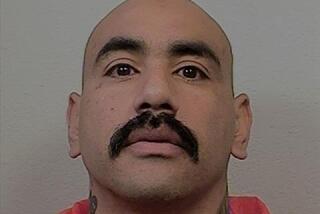A Lethal Absence of Hope
- Share via
Ronny was killed in February. He was 19, a Marine just returned from Afghanistan and on a weekend pass from Camp Pendleton. He was not a gang member, though his older brother, Angel, was. Angel was one of our first workers at Homeboy Silkscreen and managed to graduate from high school.
Outside his mother’s Boyle Heights home, gang members asked Ronny, “Where you from?” He answered, “Nowhere,” the traditional response meaning one is a member of no gang. Perhaps then he was going to say, “The Marines.” They killed him before he could say more.
Ronny’s mother, Soledad, in the months after her son’s death, found it increasingly difficult to free herself from the grip of this dark force. She wore only black clothes and quit her job, and even the recent birth of Ronny’s daughter could not extricate her from her state of constant mourning. Until the morning of Sept. 15.
Soledad woke up, looked in the mirror, decided to return to work, never wear black clothes again and, for the first time in seven months, put on makeup. Angel told her how beautiful she looked, hugged her and said, “It’s about time.”
Later that evening, as Angel was sitting on the front porch escaping the heat of the house, a car passed, caught sight of him and aimed. Several bullets found his head.
When I arrived at the house, I found Soledad slumped in a chair. Forget the handkerchief. She was sobbing into a bath towel. We talked and cried together. And my arms felt too short to wrap around her pain.
I buried Angel last month.
Gang violence is always about something else. The trick, of course, is to find the “something else.”
More than 10,000 people have been killed on our streets because of gang violence. The rate of gang-related homicides in the Los Angeles Police Department’s Hollenbeck Division has already exceeded last year’s. Surely contending with gang violence will be at the top of the agenda of the new Los Angeles police chief.
What do we know to be true about gang violence? We know we will fail if we fixate on the symptoms and not address what undergirds it. You can’t reason with gang violence; you can’t talk to it, sit it at the table and negotiate with it.
It’s akin to 19th century medical professionals staring at vexing diseases, unable to find their cure. Then, quite inadvertently, the sewer system and the water supply were addressed and diseases started to disappear. It turned out the diseases were about “something else.”
The new police chief will need to keep officers in our communities for a longer period than we’re used to. Knowledge of our streets and the people who live there would seem to be the only way to provide a “police service” that keeps us safe. But that alone would not locate the roots of such violence, which is necessary to reverse this alarming trend.
Legislators seek, often enough, to create laws that they hope will cause gang members to “think twice” before committing crimes. Deterrence has never worked with those who have ceased to care. Moreover, the gulf that separates us from each other only widens when we see gang members as foreign, “the other,” “them.”
Recent Times editorials on gangs seem incapable of not using the word “thug,” heightening the use of the language that demonizes. This is never helpful because we then soon forget that we belong to each other. Forgetting this keeps us distant from real solutions.
I once sat on a grandstand next to Boston Celtic great Bob Cousy. He said to me, quite simply, “Kids join gangs when they’ve been denied their hope.” Not bad. None of us ought to expect the new LAPD chief to manufacture hope in our poorest communities. That’s not his job; it’s ours. We know what the “something else” is; we need only find the will to do something about it.
More to Read
Sign up for Essential California
The most important California stories and recommendations in your inbox every morning.
You may occasionally receive promotional content from the Los Angeles Times.










